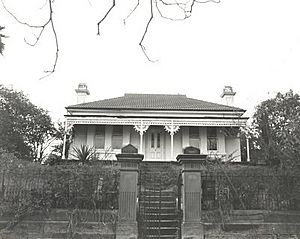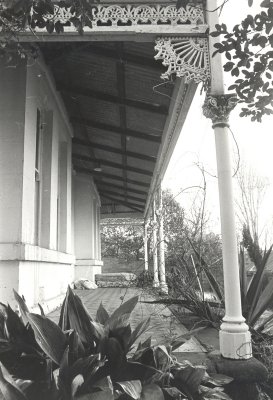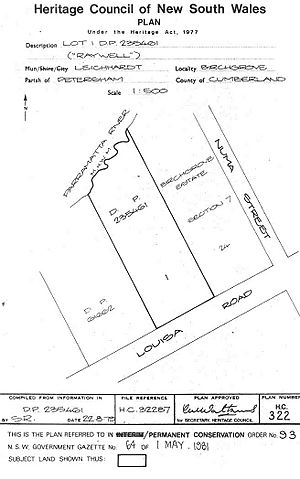Raywell, Birchgrove facts for kids
Quick facts for kids Raywell |
|
|---|---|
 |
|
| Location | 144 Louisa Road, Birchgrove, Inner West Council, Sydney, New South Wales, Australia |
| Official name: Raywell; Carnegie House | |
| Type | state heritage (built) |
| Designated | 2 April 1999 |
| Reference no. | 93 |
| Type | House |
| Category | Residential buildings (private) |
| Lua error in Module:Location_map at line 420: attempt to index field 'wikibase' (a nil value). | |
Raywell, also known as Carnegie House, is a special old home located at 144 Louisa Road in Birchgrove, Sydney, Australia. It's considered a very important historical building. Because of its history and unique style, it was added to the New South Wales State Heritage Register on April 2, 1999. This means it's protected and its history is preserved for future generations.
Contents
The Story of Raywell
Early Days of Birchgrove
The area where Raywell stands, Birchgrove, was once known as Yur(r)ulbin by the Wangal people. This name means "swift running waters." It's a place where the waters of Port Jackson meet the Parramatta River.
In 1796, a large piece of land was given to George Whitfield. This land became "Whitfield's Farm." Later, it was called "Birch Grove" and then "Birchgrove." In 1810, the land went to John Birch, who built Birch Grove House. This house became the center of the Birch Grove Estate.
Developing the Area
Over the years, the estate was sold and rented by many people. In 1860, a man named Didier Joubert tried to divide the land into smaller blocks to sell. This was called a "subdivision." However, it wasn't very successful at first.
Later, a new group of people tried again in 1878, and this time it worked much better. Many new streets in the area were named after Joubert's family. Louisa Road is named after his wife, Numa Street for his son, Rose Street for his daughter, and Ferdinant Street for his nephew. Louisa Road was carefully planned to create many building lots with good water access.
Creating Birchgrove Oval
The Government of New South Wales bought 36 lots from the estate. They used this land to create the Birch Grove Recreation Ground, which is now known as Birchgrove Oval. People were worried about pollution, so they worked to clean up Snail's Bay nearby.
In 1882, a plan was made for landscaped gardens, walking paths, and a large cricket ground. This helped improve the area. By 1887, a wall was built to reclaim swampy land. Work continued on the park, and by 1904, it had a tennis pavilion and a grandstand. Today, large fig trees frame the oval, reminding us of the old estate. Birch Grove House itself was taken down in 1967.
Building Raywell House
Raywell was built on a block of land that was bought by Albert Elkington in 1882. He sold the property to Duncan Smith in July 1883. Smith built the house around 1883. In 1885, Smith sold the house to R. William Ainsworth.
The house became known as "Raywell" because of Rachel Cole Wells. She was a single woman who lived there for a long time, from 1888 to 1928.
Later Owners and Restoration
In 1930, Margaret and Catherine Lycette bought Raywell. They lived there with their husbands and other family members. During their time, the house had a maroon roof and a large fig tree. The front and back porches were tiled. The back garden even reached the waterfront. The Lycette family owned the house until 1960.
At some point, the house was changed into several separate apartments. In 1979, there were talks about tearing Raywell down. However, a special order was put in place to protect it. In 1980, a new owner bought the property. This owner wanted to save the house and supported making it a permanently protected heritage site. This happened on May 1, 1981.
The new owner also worked to restore the house. They changed the apartments back into a single home. This big restoration project included fixing fireplaces, windows, and doors. They also restored the porches and iron railings. They put in new bathrooms and a new kitchen. This work helped bring Raywell back to its original beauty.
What Raywell Looks Like
Raywell is a beautiful old house built around 1883. It has a classic Victorian style. It started as a single-story bungalow. Later, a two-story addition was built on the north side, making it look a bit like a terrace house.
The house sits in a great spot on the ridge of Long Nose Point. It has amazing views of the harbor. You can see the Gladesville Bridge, Hunters Hill, and Cockatoo Island. You can also see the Sydney city skyline and the Harbour Bridge. A nice sandstone fence with pickets marks the front of the property along Louisa Road.
Inside, many of the original parts of the house are still there. Even though the building had some damage and was changed into apartments, many details have been carefully fixed. For example, the original marble fireplaces were stolen, but new ones have been put in.
Why Raywell is Special
Raywell was built in 1885. It is a single-story Victorian house with a bungalow style. It is in a very noticeable spot on the ridge of Long Nose Point. It is known as the only building in its area with clear architectural beauty.
Raywell was officially added to the New South Wales State Heritage Register on April 2, 1999. This means it's recognized as an important part of history and architecture in New South Wales.



